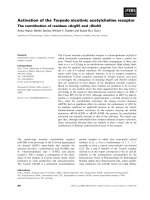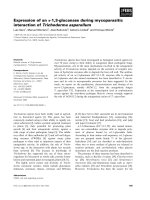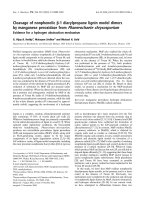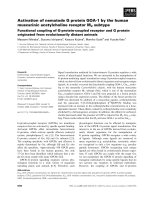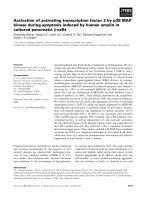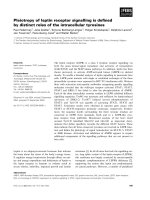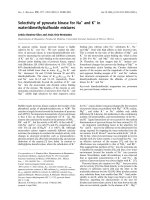Báo cáo khoa học: Activation of p21-activated kinase 1 is required for lysophosphatidic acid-induced focal adhesion kinase phosphorylation and cell motility in human melanoma A2058 cells potx
Bạn đang xem bản rút gọn của tài liệu. Xem và tải ngay bản đầy đủ của tài liệu tại đây (340.01 KB, 9 trang )
Activation of p21-activated kinase 1 is required for lysophosphatidic
acid-induced focal adhesion kinase phosphorylation and cell motility
in human melanoma A2058 cells
In Duk Jung
1
, Jangsoon Lee
1
, Kyung Bok Lee
1
, Chang Gyo Park
1
, Yong Kee Kim
2
, Dong Wan Seo
3
,
Dongeun Park
4
, Hyang Woo Lee
5
, Jeung-Whan Han
5
and Hoi Young Lee
1
1
College of Medicine, Konyang University, Nonsan, Korea;
2
College of Medicine, Kwandong University, Gangneung, Korea;
3
Laboratory of Pathology, NCI, National Institutes of Health, Bethesda, MD, USA;
4
School of Biological Sciences,
Seoul National University, Korea;
5
College of Pharmacy, Sungkyunkwan University, Suwon, Korea
Lysophosphatidic acid (LPA), one of the naturally occurring
phospholipids, stimulates cell motility through the activation
of Rho family members, but the signaling mechanisms
remain to be elucidated. In the present study, we investigated
the roles of p21-activated kinase 1 (PAK1) on LPA-induced
focal adhesion kinase (FAK) phosphorylation and cell
motility. Treatment of human melanoma cells A2058 with
LPA increased phosphorylation and activation of PAK1,
which was blocked by treatment with pertussis toxin and
by inhibition of phosphoinositide 3-kinase (PI3K) with an
inhibitor LY294002 or by overexpression of catalytically
inactive mutant of PI3Kc, indicating that LPA-induced
PAK1 activation was mediated via a Gi protein and the
PI3Kc signaling pathway. In addition, we demonstrated that
Rac1/Cdc42 signals acted as upstream effector molecules
of LPA-induced PAK activation. However, Rho-associated
kinase, MAP kinase kinase 1/2 or phospholipase C might
not be involved in LPA-induced PAK1 activation or cell
motility stimulation. Furthermore, PAK1 was necessary for
FAK phosphorylation by LPA, which might cause cell
migration, as transfection of the kinase deficient mutant of
PAK1 or PAK auto-inhibitory domain significantly abro-
gated LPA-induced FAK phosphorylation. Taken together,
these findings strongly indicated that PAK1 activation was
necessary for LPA-induced cell motility and FAK phos-
phorylation that might be mediated by sequential activation
of Gi protein, PI3Kc and Rac1/Cdc42.
Keywords: focal adhesion kinase; lysophosphatidic acid;
motility stimulation; p21-activated kinase 1.
Cell migration is a critical feature of several physiological
and pathological processes, including embryogenesis,
wound healing, immunity, angiogenesis and metastasis [1].
The locomotion involves a series of cycles that include
extension of lamellipods, cell adhesion, actin cytoskeleton
reorganization and detachment. Accumulating evidence
suggests that depending on the kind of chemoattractant and
cellular system, various intracellular signaling molecules
such as phosphoinositide 3-kinase (PI3K), phospholipase C
(PLC), mitogen-activated protein kinase (MAPK) and
protein kinase C (PKC) are differentially involved in the
stimulation of motility [2].
Lysophosphatidic acid (LPA) is a lipid mediator that
evokes hormone- and growth factor-like responses in almost
every mammalian cell types [3]. LPA exerts diverse biolo-
gical effects, including cell proliferation/survival, induction
of neurite retraction, inhibition of gap junctional commu-
nication and cell motility [3,4]. Moreover, LPA represents
the major mitogenic activity in serum, and platelet-derived
LPA is an important mediator in wound healing and tissue
regeneration [5]. Most of these LPA actions are mediated
through the lipid-specific G protein-coupled receptors
(GPCRs), termed LPA1/EDG-2, LPA2/EDG-4, and
LPA3/EDG-7 [3,4,6], although recent studies suggested
another type of GPCR for the LPA, LPA4/GPR23 [7].
Rho family members such as Rho, Rac and Cdc42 are part
of the Ras superfamily of small GTP-binding proteins that
act as guanine nucleotide-regulated switches [8]. While Rho
stimulates the formation of actin stress fibers and focal
adhesions, Cdc42 controls the extension of filopodia and Rac
activation triggers formation of lamellipodia [8]. Activated
Rho family GTP-binding proteins activate various down-
stream effector proteins including p21-activated kinases
(PAK). PAK binds GTP-Rac at their CRIB (Cdc42/Rac
interactive binding) motif in an adhesion-dependent manner
[9]. Moreover, PAK can be activated by GTP-loaded Cdc42
and through a variety of pathways originating from growth
Correspondence to H. Y. Lee, Department of Pharmacology, College
of Medicine, Konyang University, Nonsan 320-711, Korea.
Fax: + 82 41 7354626, Tel.: + 82 41 7305291,
E-mail:
Abbreviations: EGFR, epidermal growth factor receptor; ERK,
extracellular signal-regulated kinase; FAK, focal adhesion kinase;
FRNK, FAK-related nonkinase; GIT, G protein coupled receptor
kinase-interacting targets; GPCR, G protein-coupled receptor; LPA,
lysophosphatidic acid; LPC, lysophosphatidylcholine; MAPK, mito-
gen-activated protein kinase; PAK1, p21-activated kinase 1; PI3K,
phosphatidylinositide 3-kinase; PID, PAK auto-inhibitory domain;
PLC, phospholipase C; PTX, pertussis toxin; PKC, protein kinase C;
ROCK, Rho-associated kinase.
(Received 2 January 2004, revised 26 February 2004,
accepted 2 March 2004)
Eur. J. Biochem. 271, 1557–1565 (2004) Ó FEBS 2004 doi:10.1111/j.1432-1033.2004.04066.x
factor receptors, GPCR and integrins [10]. PAK regulates
myosin light chain phosphorylation via myosin light chain
kinase [11] and direct phosphorylation [12].
Focal adhesion kinase (FAK) is a cytoplasmic protein-
tyrosine kinase that localizes to focal adhesion [13]. FAK
can be phosphorylated by growth factors and during
formation of focal adhesions and spreading [14]. GPCR
agonists including LPA appear to induce tyrosine phos-
phorylation of FAK via a Rho-dependent pathway that
leads to the formation of actin stress fibers and to the
assembly of focal adhesions [15]. Activated FAK in turn
recruits other proteins, including paxillin, p130
Cas
, vinculin
and talin in focal adhesions. These protein complexes
anchor the actin cytoskeleton and provide structural
integrity to cells [16]. The importance of FAK-mediated
signal transduction on cell motility is underlined by
experiments showing FAK signaling activity and their
implications in the control of cell motility [17].
Recently, Schmitz et al. reported that LPA stimulated
PAK in vascular smooth muscle cells, and PAK activation
was dependent on Src and generation of reactive oxygen
species [18]. Despite the importance of PAK and FAK in
cell motility and LPA-induced FAK activation via RhoA or
Rho-associated kinase (ROCK) [19], there has been no
direct evidence showing the roles of PAK activation on
LPA-induced FAK phosphorylation and cell motility.
Therefore, we undertook to investigate the roles of PAK1
activation in LPA-induced cell motility and present herein
strong evidence that PAK1 activation is involved in LPA-
induced FAK phosphorylation and human melanoma cell
motility.
Materials and methods
Antibodies and other reagents
LY294002, PD98059, genistein and pertussis toxin (PTX)
were purchased from Calbiochem (San Diego, CA, USA).
Antibodies raised against FAK and phosphotyrosine
(PY20) were purchased from Transduction Laboratories
(Lexington, KY, USA) and anti-PAK1 was from Santa
Cruz Technology (Santa Cruz, CA, USA). Y27632 was
from Tocris (Bristol, UK), Sepharose 4B from Amersham
Bioscience (Seoul, Korea) and myelin basic protein (MBP)
was from Sigma (Seoul, Korea). All other reagents from
various commercial sources were of analytical grade.
Cell culture
The human melanoma cell line A2058 was maintained as
described previously [20]. The cells were maintained at
37 °C in Dulbecco’s modified Eagle’s medium supplemen-
ted with 10% fetal bovine serum in a humidified 5% CO
2
.
For analysis of LPA-induced signals, cells in exponential
growth were extensively washed to remove growth factors
and resuspended in serum-free media (basal media) for 12 h
to induce maximum synchronization.
Expression plasmids and transfection
Vectors (pEBG/myc) expressing the catalytically inactive
mutants, N17Rac1, N17Cdc42 and N19RhoA, and
pcDNA3 expressing the catalytically inactive mutant of
PI3Kc with isoprenylation signal of K-Ras, PI3Kc K832R,
have been described in a previous report [21]. pEBB/HA
expressing the PAK1 mutant whose kinase activity was
eliminated (PAK1 K299R) [22], pcDNA3/HA expressing
the wild-type PAK inhibitory domain (PID: corresponding
to residues 83–149 of hPAK1) or L107F mutant of PID [22],
pcDNA3.1 expressing the noncatalytic C-terminal domain
of FAK, termed FAK related nonkinase (FRNK) [23], and
lipase-inactive mutant of PLCc1(PLCc1 H335Q) [24] were
used in this study. A2058 melanoma cells were transiently
transfected with each vectors using SuperFect
TM
transfec-
tion system (Qiagen), as previously described in detail [25].
FRNK and its corresponding vector were stably transfected
into A2058 cells by selecting the cells with G418. Cells were
washed with phosphate-buffered saline (NaCl/P
i
)and
grown in complete medium for 36 h before analyses of cell
motility, immunoprecipitation
and immunoblotting.
Immunoprecipitation and immunoblotting
Cell lysates were prepared with lysis buffer (50 m
M
Tris/
HCl, pH 7.4, 1% Nonidet P-40, 150 m
M
NaCl, 1 m
M
EDTA, 1 m
M
phenylmethylsulfonyl fluoride, 1 lgÆmL
)1
aprotinin, 1 lgÆmL
)1
leupeptin, 1 m
M
sodium orthovana-
date and 1 m
M
NaF) and FAK was precipitated from the
cell lysates (400 lg of total protein) with specific antibodies
for 3 h at 4 °C. Protein–antibody complexes were collected
with protein A-Sepharose beads for 3 h at 4 °C. The
precipitates were washed three times with ice-cold lysis
buffer and resolved by 8% SDS/PAGE. Tyrosine phos-
phorylation and protein levels of FAK were assessed by
immunoblotting with antiphosphotyrosine (PY20) or the
specific antibodies as used for precipitations. Immunolabe-
ling was detected by ECL (Amersham Life Science, Inc),
according to the manufacturer’s instructions.
Small G protein pull-down assays
The Cdc42-GTP and Rac1-GTP pull-down assay was
modified from Benard et al.[26].Inbrief,cellswerewashed
with ice-cold NaCl/P
i
and lysed with lysis buffer (150 m
M
NaCl, 0.8 m
M
MgCl
2
,5m
M
EGTA, 1% NP-40, 50 m
M
Hepes, pH 7.5, 1 m
M
phenylmethanesulfonyl fluoride,
10 lgÆmL
)1
leupeptin and 10 lgÆmL
)1
aprotinin). After
centrifugation at 14 000 g for 5 min, 20 lL of 50% slurry of
GST-PAK-PBD glutathione-Sepharose 4B was added to
the cell lysate and incubated for 45 min at 4 °C. Proteins
bound to beads were washed with 50 m
M
Tris/HCl, PH 7.2,
1% Triton X-100, 150 m
M
NaCl, 10 m
M
MgCl
2
,1m
M
phenylmethanesulfonyl fluoride, 10 lgÆmL
)1
leupeptin,
10 lgÆmL
)1
aprotinin and eluted in Laemmli sample buffer.
Proteins were analyzed by Western blotting using antibodies
against Cdc42 or Rac1.
PAK kinase assay
Cells were lysed in lysis buffer (50 m
M
Hepes pH 7.5,
150 m
M
NaCl, 1% NP-40, 0.5% sodium deoxycholate,
10 lgÆmL
)1
leupeptin, 1 m
M
phenylmethylsulfonyl fluoride,
2.5 lgÆmL
)1
aprotinin, 5 m
M
sodium fluoride, 1 m
M
sodium orthovanadate) and the equivalent protein concen-
1558 I. D. Jung et al. (Eur. J. Biochem. 271) Ó FEBS 2004
trations of cell lysates were precleared with normal IgG and
Protein A Sepharose. After centrifugation, the supernatants
were immunopricipitated with an appropriate primary
antibody as described [22]. MBP was used as a substrate
for PAK. Phosphorylated proteins were electrophoresed on
12% SDS/PAGE gels for detecting phosphorylated MBP.
Cell motility assays
Motility assays were performed in triplicate using a 48 well
microchemotaxis chamber for 4 h as previously described in
detail [27]. Briefly, cells were harvested using a trypsin/
EDTA solution and resuspended in Dulbecco’s modified
Eagle’s medium supplemented with 1 mgÆmL
)1
bovine
serum albumin at a concentration 2 · 10
6
cellsÆmL
)1
.The
bottom of the wells were filled with LPA. Gelatin-coated
polyvinyl pyrrolidine-free polycarbonate filters with 8 lm
pores membranes (Neuroprobe, Inc.), used in these modi-
fied Boyden chambers, were fixed and stained with Diff-
Quik reagents (Dade Behring, Inc.). Chemotaxis was
densitometrically quantified using
EAGLESIGHT
software
v3.2 (Stratagene) for data analysis, as described previously
[25].
Statistical analysis
Results are expressed as means ± SE and an analysis was
carried out by one-way Student’s t-test. P-values less than
0.05 were considered statistically significant.
Results
Lysophosphatidic acid causes PAK1 activation
PAKs are serine/threonine kinases that serve as important
mediators of Rac- and Cdc42-GTPase, and possibly
sphingolipid signaling [28]. The Rac/PAK pathway is
known to play an essential role in cell motility [29] and
proliferation [30]. In order to test the effects of LPA on
PAK1 activity in A2058 human melanoma cells, serum
starved cells were stimulated by 2 l
M
LPA for various
periods of time, and PAK1 activity was accessed with MBP
as a substrate after immunoprecipitation with an antibody
raised against PAK1. Activation of PAK1 by LPA was
maximalat5minincubationwith7.8-foldincrease,and
returned to basal level at 25 min (Fig. 1). The data indicated
that LPA stimulated PAK1 in A2058 cells.
A Gi protein, PI3Kc and tyrosine kinase, but not ROCK,
are involved in LPA-induced PAK1 activation
LPA receptor is coupled with G proteins, which activate
Rho to induce the formation of actin stress fibers and focal
adhesion [31]. LPA1 and LPA2 receptors couple to MAPK/
ERK, PLC and RhoA-dependent signaling cascade, while
LPA3 receptors activate only MAPK/ERK and PLC
pathways [32]. A Gi protein has been shown to regulate
Rac and Cdc42 during LPA-induced cell spreading [33],
while not being involved in sphingolipid-induced PAK1
activation [34], and PI3K activation is shown to be
necessary for LPA-induced Rac activation in B103 neuro-
blastoma cells [34]. Therefore, the possible involvement of
G protein, PI3K, PLC and MAPK in LPA-induced PAK1
activation was examined. A2058 cells were pretreated
individually with each of PTX (100 ngÆmL
)1
;Giprotein
inhibitor), LY294002 (10 l
M
; PI3K inhibitor), U73122
(10 l
M
; PLC inhibitor) and PD98059 (25 l
M
;MAPK/ERK
inhibitor), followed by LPA treatment. PTX and LY294002
markedly inhibited LPA-induced PAK1 activation, indica-
ting that LPA-induced PAK1 activation depends on Gi and
PI3K in A2058 cells (Fig. 2A). However, either U73122 or
PD98059 did not inhibit LPA-induced PAK1 activation. In
addition, PAK1 activation by LPA was efficiently inhibited
by tyrosine kinase inhibitor, genistein, but not by ROCK
inhibitor, Y27632 (Fig. 2A), indicating that RhoA might
not be involved in LPA-induced PAK1 activation. Trans-
fection of lipase-inactive mutant of PLCc1(PLCc1 H335Q)
and the catalytically inactive mutant of PI3Kc (PI3Kc
K832R) to A2058 cells further confirmed our findings:
LPA-induced PAK1 activation in the PI3Kc K832R-
transfected cells was profoundly inhibited compared to that
of the vector transfected cells, while PAK1 in the
PLCc1 H335Q-transfected cells was still activated by LPA
(Fig. 2B). Considering the transfection efficiency of 65% in
our system, about 54% reduction of PAK1 activation in
PI3Kc K832R transfectant suggests that PI3Kc is involved
in LPA-induced PAK1 phosphorylation.
Rac1 and Cdc42 are required for LPA-induced PAK1
activation
Rho-like GTPases, including Rac1, Cdc42 and RhoA, have
been implicated in the control of a wide range of biological
processes, such as the regulation of cytoskeletal structures,
adhesion, motility, transcriptional activation and cell cycle
Fig. 1. LPA stimulates PAK1 in A2058 cells. The cells were serum-
starved for 12 h and then stimulated with 2 l
M
LPA for the indicated
time points (control ¼ time point 0). PAK1 activity was assessed by
PAK immunocomplex MBP in-gel kinase assay, as described under
Materials and methods, and MBP phosphorylation was assessed by
autoradiography. Data are presented as mean values with standard
errors of three experiments.
Ó FEBS 2004 LPA-induced cell motility requires PAK activation (Eur. J. Biochem. 271) 1559
progression [8]. However, the role of Rho family for LPA-
induced cell motility is still not clear. Recently, we identified
that the LPA-producing lysophospholipase D, autotaxin,
can increase the levels of Cdc42-GTP and Rac1-GTP via the
activation of PI3Kc [21]. In the present study, direct pull-
down assay confirmed that LPA increased the levels of
GTP-Rac1 and GTP-Cdc42 (Fig. 3A). Next, A2058 cells
were transfected with dominant negative mutants of each of
Rac1, Cdc42 and RhoA to assess the involvement of Rho
family members in LPA-induced PAK1 activation.
N17Rac1- or N17Cdc42-transfected cells showed reduced
activation of PAK1 by LPA, compared to the correspond-
ing vector transfectant. However, PAK1 in the N19RhoA-
transfected cells was still activated by LPA, indicating that
Rac1 and Cdc42, but not RhoA, are located upstream of
PAK1 during LPA-induced PAK1 activation in A2058 cells
(Fig. 3B). This was in agreement with the data in Fig. 2A
showing that ROCK inhibitor, Y27632, did not inhibit the
activation of PAK1 by LPA in A2058 cells.
PAK1 activation is required for LPA-induced FAK
phosphorylation and motility
LPA has been shown to increase phosphorylation of FAK
in human osteosarcoma cells [35] and preosteoblastic cells
[36]. However, little is known about the mechanism of LPA-
induced FAK phosphorylation, except the inhibition of
LPA-induced FAK phosphorylation by Y27632 in osteo-
sarcoma cells [35] and in rat ascite hepatoma cells [37]. As
RhoA was not required for LPA-induced PAK1 activation
(Fig. 2A and Fig. 3), we examined the effects of PAK1
activation on LPA-induced FAK phosphorylation. To test
the roles of PAK1 activation on LPA-induced FAK
phosphorylation, cells were transfected with either vector
or the kinase-inactive mutant of PAK1, PAK1 K299R. As
shown in Fig. 4A, A2058 cells transfected with PAK1
K299R showed reduced FAK-phosohorylation, indicating
that activation of PAK1 by LPA is involved in FAK
phosphorylation in A2058 cells. Furthermore, LPA-induced
FAK phosphorylation was greatly reduced in the cells
expressing the PID (Fig. 4B). However, inactive PID
mutant (PID L107F) expression did not block LPA-induced
FAK phosphorylation under the same conditions, con-
forming that PAK kinase activity is essential for LPA-
induced FAK phosphorylation. PAK has been reported to
Fig. 2. LPA-induced PAK1 activation depends on Gi, PI3Kc,and
tyrosine kinases. (A) A2058 cells were pretreated with PTX
(100 ngÆmL
)1
, 6 h), LY294002 (10 l
M
, 1 h), U73122 (10 l
M
,0.5h),
PD98059 (25 l
M
,1h),genistein(100l
M
, 1 h), Y27632 (100 l
M
,1h)
and further incubated with or without 2 l
M
LPA for 5 min, and PAK1
activity was assessed by PAK immunocomplex MBP in-gel kinase
assay, as described under Materials and methods. MBP phosphory-
lation was assessed by autoradiography. Data are presented as mean
values with standard errors of three experiments. (B) After transfection
with each of PI3Kc K832R, PLCc1 H335Q and the corresponding
control vectors, A2058 cells were incubated with or without 2 l
M
LPA
for 5 min, and PAK1 activity was assessed by PAK immunocomplex
MBP in-gel kinase assay, as described under Materials and methods.
MBP phosphorylation was analyzed by autoradiography. Data are
presented as mean values with standard errors of three experiments.
1560 I. D. Jung et al. (Eur. J. Biochem. 271) Ó FEBS 2004
regulate cell motility in mammalian fibroblasts [38] and in
vascular smooth muscle cells [39]. However, little is known
about the roles of PAK in LPA-induced cell motility, except
PAK activation by LPA [18]. Therefore, the role of PAK1
on LPA-induced cell motility was examined in the cells
transfected with either vector or PAK1 K299R by modified
Boyden chamber motility assay. As shown in Fig. 5,
motility of PAK1 K299R-transfected cells in the presence
of LPA was markedly slower than that of vector transfect-
ant, indicating that the activation of PAK1 is necessary for
LPA-induced A2058 cells motility.
FAK is required for LPA-induced cell motility
FAK signaling is modulated by expression of an endo-
genous FAK inhibitor, FRNK, which is expressed as an
independent protein and consists of the carboxyl-terminal
noncatalytic domain of FAK [40]. Although ectopically
Fig. 4. PAK1 activation is required for FAK phosphorylation. (A) After
transfection with vector or PAK1 K299R, the cells were incubated in
the absence or presence of 2 l
M
LPAfor5min.Celllysateswere
immunoprecipitated (IP) with an antibody raised against FAK, fol-
lowed by immunoblotting (IB) with the phosphotyrosine antibody
(PY20). (B) After transfection with vector, PID, and inactive PID
(L197F), the cells were incubated in the absence or presence of 2 l
M
LPA for 5 min. Cell lysates were immunoprecipitated (IP) with an
antibody raised against FAK, followed by immunoblotting (IB) with
the phosphotyrosine antibody (PY20). Data shown are representatives
of six experiments with similar results. Data are presented as mean
values with standard errors of six experiments.
Fig. 3. PAK1 activation depends on Cdc42 and Rac1. (A) A2058 cells
were serum-deprived and treated with or without 10 l
M
LY294002
(LY) for 1 h before incubating with LPA (2 l
M
) for 5 min. Cellular
extracts were incubated with GST-PAK-PBD beads. The bound pro-
teins (GTP-Rac1 and GTP-Cdc42) were analyzed by Western blot
analysis using antibodies specific for Rac1 or Cdc42. Data shown are
representative of three experiments with similar results. (B) A2058 cells
were transiently transfected with each of the dominant negative forms
(N17Rac1, N17Cdc42 and N19RhoA) and the corresponding control
vectors, and the cells were incubated in the absence or presence of 2 l
M
LPA for 5 min. PAK1 activity was assessed by PAK immunocomplex
MBP in-gel kinase assay, as described under Materials and methods,
and MBP phosphorylation was analyzed by autoradiography. Data
are presented as mean values with standard errors of three experiments.
Ó FEBS 2004 LPA-induced cell motility requires PAK activation (Eur. J. Biochem. 271) 1561
expressed FRNK is directed to focal adhesions upon
overexpression in fibroblasts and inhibits FAK-mediated
signaling events, the role of endogenously expressed FRNK
in focal adhesion signaling is unclear [41]. To determine
the significance of FAK association with respect to LPA-
induced cell motility, FRNK was stably transfected as a
dominant-negative inhibitor of FAK function in A2058
melanoma cells and then was assayed for LPA-activated
FAK phosphorylation (Fig. 6A) and cell motility (Fig. 6B).
Unlike the cells transfected with vector alone, transfection
of FRNK potentially inhibited both LPA-induced FAK
phosphotylation and cell motility. Considering the roles of
PAK1 in FAK phosphorylation (Fig. 4A,B), FAK located
downstream of PAK1 is required for LPA-induced A2058
cell motility.
Discussion
PAKs play an important role in a variety of cellular
functions including cell morphogenesis, motility, survival,
angiogenesis and mitosis [42]. Recently, LPA was reported
to increase PAK phosphorylation without direct evidence
showing the involvement of the activated PAK to LPA-
induced cell motility. In the present study, we clearly
demonstrated that PAK1 activation was required for FAK
phosphorylation to increase cell motility by LPA in A2058
human melanoma cells.
Activation of PAK is regulated intracellularly by various
factors upon growth factor stimulation. In addition to Rho
GTPases [43], Nck, guanine nucleotide factor PIX and
paxillin have been shown to activate PAKs [44–46]. In the
present study, pull-down assay identified the increased
complex formation of PAK with either Rac1 or Cdc42.
Moreover, expression of dominant negative mutant of
Cdc42 or Rac1, but not Rho, completely abrogated the
LPA-induced PAK activation (Fig. 3A), indicating that
Cdc42 and Rac1 are located upstream of PAK during LPA
stimulation. Although Rho was implicated in LPA-induced
cell motility in glioma cell [47] and in ovarian cancer cell [19],
our observations are in accordance with Cdc42/Rac-
dependent and RhoA independent enhancement of cell
motility by Vav3 [48] and VEGF [49]. Furthermore, recent
Fig. 6. FRNK inhibits LPA-stimulated FAK phosphorylation and cell
motility. (A) The cells were transfected with vector or FRNK and
selected by G418. After incubating in the absence or presence of 2 l
M
LPA for 5 min, cell lysates were analyzed by SDS/PAGE and
immunoprecipitation (IP) using an antibody raised against FAK and
then followed by immunoblotting (IB) with the phosphotyrosine
antibody (PY20) and immunoblotting (IB) using an antibody for the
C-terminus of FAK. Data are presented as mean values with standard
errors of three experiments. (B) After transfection with vector or
FRNK, motility was assessed with a modified Boyden chamber assay
against control or LPA. Data are presented as mean values with
standard errors of three experiments. *, P < 0.05 compared with
vector transfected cells.
Fig. 5. Activation of PAK1 is necessary for LPA-induced cell motility.
After transfection with vector or PAK1 K299R, motility was assessed
with modified Boyden chamber assay against control or LPA. Data
are presented as mean values with standard errors of three experi-
ments. *, P < 0.05 compared with vector transfected cells.
1562 I. D. Jung et al. (Eur. J. Biochem. 271) Ó FEBS 2004
LPA data suggested that LPA1 receptors activate Rac, with
consequent suppression of RhoA activity, and thereby
stimulate cell spreading and motility in neuroblastoma cells
[34]. It is possible that different small G proteins are
involved in LPA-induced cell motility in different cell types.
LPA stimulates tyrosine phosphorylation of FAK [50],
and FAK is a nonreceptor protein-tyrosine kinase that is
localized at focal contact sites and plays a critical role in
controlling cell migration [17]. Rho and ROCK have been
suggested as possible regulators of LPA-induced FAK
phosphorylation [43]. Recently, we have provided the
evidence that Rac and Cdc42, but not Rho, were required
for PAK activation and FAK phosphorylation by autotaxin
[21]. However, little is known about the roles of PAK on
LPA-induced FAK phosphorylation. The present study
clearly demonstrated that LPA-induced PAK activation
was necessary for FAK phosphorylation as LPA-induce
FAK phosphorylation was inhibited in PAK1 K299R-
transfected cells (Fig. 4A). Furthermore, expression of PID
inhibited LPA-induced FAK phosphorylation, while PID
mutant still activated FAK in the presence of LPA
(Fig. 4B). Our data also showed the importance of PAK1
and FAK in LPA-induced A2058 cell motility. Transfection
of PAK1 K299R greatly reduced LPA-induced cell motility
(Fig. 5). Moreover, expression of FRNK in A2058 cells
blocked FAK phosphorylation as well as cell motility
induced by LPA (Fig. 6A,B). These data are in good
accordance with previous reports showing the involvement
of FAK in endothelial cell motility using FRNK [51]. As
FAK was co-immunoprecipitated with both NCK and
PAK in vascular endothelial growth factor-activated endo-
thelial cells [52] and G protein coupled receptor kinase
(GRK)-interacting targets (GIT) links PAK and FAK [53],
involvement of PIX, Nck and GIT in LPA-induced FAK
phosphorylation and cell motility is under current investi-
gation.
Following G protein activation by LPA, one of the
intracellular signaling events that occurs is activation of
the lipid kinase PI3K [54]. PI3Ks mediate various biological
activities of LPA, including cell proliferation or survival
[55]. In the present study, we have demonstrated that the
selective inhibitor of PI3K, LY294002 effectively inhibited
LPA-induced PAK activation (Fig. 2A), indicating that
PI3K is located upstream of PAK in LPA signaling
pathway of A2058 cells. From a molecular point of view,
two types of PI3Ks can be activated in response to LPA
stimulation. PI3Kc has the unique biochemical feature to be
directly activated by heterotrimeric G proteins and was thus
initially considered as the best candidate target of LPA [56].
On the other hand, it has been shown that the PI3Kb
isoform was important for the mitogenic activity of LPA in
nonhematopoietic cells that do not express PI3Kc [57].
PI3Kb isoform is classically activated downstream of
tyrosine kinases through the recruitment of its associated
p85 regulatory subunit to phosphotyrosine-containing
motifs. Transactivation of the epidermal growth factor
receptor (EGFR), as well as G protein bc subunits, is
thought to play an important role in PI3Kb activation [58].
In addition, the Gbc-regulated PI3Kb isoform has been
speculated to mediate LPA-induced Rac activation in
neuroblastoma cells [34]. However, recent data showed that
PI3Kc was essential for tumor cell motility-stimulating
activity of autotaxin [25]. In the present study, we have
shown that LPA-induced PAK1 activation was inhibited in
the cells transfected with catalytically inactive mutant of
PI3Kc (PI3Kc K832R), suggesting that G protein-coupled
PI3Kc was necessary for LPA-induced PAK activation
(Fig. 2B).
Signal transduction pathways that lead to activation of
ERK 1/2 by LPA have been elucidated in recent years and
have been demonstrated to include Src-dependent transac-
tivation of the EGF receptor leading to recruitment of Shc–
Grb2–Sos complex to activate EGF receptor [59], which is
followed by stimulation of Ras [60]. In mesangial cells LPA-
inducedERK1/2activationwasshowntodependon
platelet-derived growth factor (PDGF) receptor transacti-
vation and not EGF receptor transactivation [61]. However,
specific inhibition of PDGF and EGFR kinases had no
effect on LPA-induced PAK activation [18]. To further
elucidate signal transduction pathways that mediated LPA-
induced stimulation of PAK in A2058 cells, cells were
pretreated with either tyrosine kinase inhibitor, genistein, or
MAP kinase inhibitor, PD98059. Inhibition of tyrosine
kinase by genistein greatly inhibited LPA-induced PAK
activation, whereas MAP kinase activity was not required
(Fig. 2A). In supporting our data about the dependence of
LPA-induced PAK activation on tyrosine kinase, Schmitz
et al. recently reported that Src inhibitor PP1 effectively
inhibited LPA-induced PAK activation in vascular smooth
Fig. 7. A model showing the signaling pathway that possibly mediates
LPA-induced cell migration in the A2058 melanoma cell. Inhibitors or
mutants that blocked each step are shown in the right side of the figure.
Ó FEBS 2004 LPA-induced cell motility requires PAK activation (Eur. J. Biochem. 271) 1563
muscle cells [18]. At present, however, we do not know how
tyrosine phosphorylation could be involved in LPA activa-
tion of PAK1.
In conclusion, the present study demonstrates the
significance of PAK1 and FAK in A2058 cell motility.
Located downstream of Rac and Cdc42, LPA-induced
PAK phosphorylation was important to FAK phosphory-
lation (Fig. 7). However, either RhoA or ROCK was
not involved in LPA-induced PAK activation and cell
motility.
Acknowledgements
This study was supported by a Korea Research Foundation Grant
(KRF-2002-015-EP0129). We would like to thank Dr Pann Ghill Suh
for PLCc1 H335Q and Dr Satyajit Mitra for pcDNA3.1 FRNK.
References
1. Singer, S.J. & Kupfer, A. (1986) The directed migration of
eukaryotic cells. Annu.Rev.CellBiol.2, 337–365.
2. Kassis, J., Lauffenburge, D.A., Turner, T. & Wells, A. (2001)
Tumor invasion as dysregulated cell motility. Semin. Cancer Biol.
11, 107–117.
3. Moolenaar, W.H. (1999) Bioactive lysophospholipids and their
G protein-coupled receptors. Exp. Cell Res. 253, 230–238.
4. Contos, J.J., Ishii, I. & Chun, J. (2000) Lysophosphatidic acid
receptors. Mol. Pharmacol. 58, 1188–1196.
5. Kranenburg, O. & Moolenaar, W.H. (2001) Ras-MAP kinase
signaling by lysophosphatidic acid and other G protein-coupled
receptor agonists. Oncogene 20, 1540–1546.
6. Ye, X., Ishii, I., Kingsbury, M.A. & Chun, J. (2002) Lysopho-
sphatidic acid as a novel cell survival/apoptotic factor. Biochim.
Biophys. Acta 30, 108–113.
7. Noguchi, K., Ishii, S. & Shimizu, T. (2003) Identification of p2y9/
GPR23 as a novel G protein-coupled receptor for lysophospha-
tidic acid, structurally distant from the Edg family. J. Biol. Chem.
278, 25600–25606.
8. Hall, A. (1998) Rho GTPases and the actin cytoskeleton. Science
279, 509–514.
9.delPozo,M.A.,Price,L.S.,Alderson,N.B.,Ren,X.D.&
Schawrtz, M.A. (2000) Adhesion to the extracellular matrix reg-
ulates the coupling of the small GTPase Rac to its effector PAK.
EMBO J. 19, 2008–2014.
10. Hashimoto, S., Tsubouchi, A., Mazaki, Y. & Sabe, H. (2000)
Interaction of paxillin with p21-activated kinase (PAK): associa-
tion of paxillin alpha with the kinase-inactive and the Cdc42-
activated forms of PAK3. J. Biol. Chem. 276, 6037–6045.
11. Sanders, L.C., Matsummura, F., Bokoch, G.M. & de Lanerolle,
P. (1999) Inhibition of myosin light chain kinase by p21-activated
kinase. Science 283, 2083–2085.
12. Zeng, Q., Lagunoff, D., Masaracchia, R., Goeckeler, Z., Cote, G.
& Wysolmerski, R. (2000) Endothelial cell retraction is induced by
PAK2 monophosphorylation of myosin II. J. Cell Sci. 113,
471–482.
13. Parsons, J.T., Martin, K.H., Slack, J.K., Taylor, J.M. & Weed,
S.A. (2000) Focal adhesion kinase: a regulator of focal adhesion
dynamics and cell movement. Oncogene 19, 5606–5613.
14. Abedi, H. & Zachary, I. (1997) Vascular endothelial growth factor
stimulates tyrosine phosphorylation and recruitment to new focal
adhesions of focal adhesion kinase and paxillin in endothelial cells.
J. Biol. Chem. 272, 15442–15451.
15. Ridley, A.J. & Hall, A. (1992) The small GTP-binding protein rho
regulates the assembly of focal adhesioons and actin stress fibers in
response to growth factors. Cell 70, 389–399.
16. Schlaepfer, D.D. & Hunter, T. (1998) Integrin signalling and
tyrosine phosphorylation: just the FAKs. Trends Cell Biol. 8,
151–157.
17. Gilmore, A.P. & Romer, L.H. (1996) Inhibition of focal adhesion
kinase (FAK) signaling in focal adhesions decreased cell motility
and proliferation. Mol. Biol. Cell 7, 1209–1224.
18. Schmitz, U., Thommes, K., Beier, I. & Vetter, H. (2002) Lyso-
phosphatidic acid stimulates p21-activated kinase in vascular
smooth muscle cells. Biochem. Biophys. Res. Commun. 291, 687–
691.
19. Sawada, K., Morishige, K., Tahara, M., Ikebuchi, Y., Kawagishi,
R., Tasaka, K. & Murata, Y. (2002) Lysophosphatidic acid
induces focal adhesion assembly through rho/rho-associated kin-
ase pathway in human ovarian cancer cells. Gynecol. Oncol. 87,
252–259.
20. Liotta, L.A., Mandler, R., Murano, G., Katz, D.A., Gordon,
R.K., Chiang, P.K. & Schiffmann, E. (1986) Tumor cell autocrine
motility factor. Proc. Natl Acad. Sci. USA 83, 3302–3306.
21. Jung, I.D., Lee, J., Yun, S.Y., Park, C.G., Choi, W.S., Lee, H.W.,
Choi, O.H., Han, J.W. & Lee, H.Y. (2002) Cdc42 and Rac1 are
necessary for autotaxin-induced tumor cell motility in A2058
melanoma cells. FEBS Lett. 532, 351–356.
22. Lee,S.H.,Eom,M.,Lee,S.J.,Kim,S.,Park,H.J.&Park,D.
(2001) bPix-enchanced p38 activation by Cdc42/Rac/PAK/
MKK3/6-mediated pathway. J. Biol. Chem. 276, 25066–25072.
23. Sieg, D.J., Hauck, C.R. & Schlaepfer, D.D. (1999) Required role
of focal adhesion kinase (FAK) for integrin-stimulated cell
migration. J. Cell Sci. 112, 2677–2691.
24. Kim, M.J., Kim, E., Ryu, S.H. & Suh, P.G. (2000) The mechanism
of phospholipase C-c1regulation.Exp. Mol. Med. 32, 101–109.
25. Lee, H.Y., Bae, G.U., Jung, I.D., Lee, J.S., Kim, Y.K., Noh, S.H.,
Stracke,M.L.,Park,C.G.,Lee,H.W.&Han,J.W.(2002)
Autotaxin promotes motility via G protein-coupled phosphoino-
sitide 3-kinase gamma in human melanoma cells. FEBS Lett. 515,
137–140.
26. Benard, V., Bohl, B.P., Gary, M. & Bokoch, G.M. (1999) Char-
acterization of Rac and Cdc42 activation in chemoattractant-
stimulated human neutrophils using a novel assay for active
GTPases. J. Biol. Chem. 274, 13198–13204.
27. Stracke, M.L., Krutzsch, H.C., Unsworth, E.J., Arestad, A.,
Cioce, V., Schiffmann, E. & Liotta, L.A. (1992) Identification,
purification, and partial sequence analysis of autotaxin, a novel
motility-stimulating protein. J. Biol. Chem. 267, 2524–2529.
28. Knaus, U.G. & Bokoch, G.M. (1998) The p21rac/Cdc42-activated
kinases (PAKs). Int. J. Biochem. Cell Biol. 30, 857–862.
29. Ridley, A.J. (2002) Rho family proteins: coordinating cell
responses. Trends Cell Biol. 11, 471–477.
30. Schurmann, A., Mooney, A.F., Sanders, L.C., Sells, M.A., Wang,
H.G., Reed, J.C. & Bokoch, G.M. (2000) p21-activated kinase 1
phosphorylates the death agonist bad and protects cells from
apoptosis. Mol. Cell Biol. 20, 453–461.
31. Buhl, A.M., Johnson, N.L., Dhanasekaran, N. & Johnson,
G.L. (1995) G alpha 12 and G alpha 13 stimulate rho-dependent
stress fiber formation and focal adhesion assembly. J. Biol. Chem.
270, 24631–24634.
32. Takuwa, Y. (2002) Subtype-specific differential regulation of Rho
family G proteins and cell migration by the Edg family sphingo-
sine 1-phosphate receptors. Biochim. Biophys. Acta 1582, 112–120.
33. Ueda, H., Morishita, R., Yamauchi, J., Itoh, H., Kato, K. &
Asano, T. (2001) Regulation of Rac and Cdc42 pathway by Gi
during lysophosphatidic acid-induced cell spreading. J. Biol.
Chem. 276, 6846–6852.
34. Van Leeuwen, F.N., Olivo, C., Giepmans, B.N., Collard, J.G. &
Moolenaar, W.H. (2003) Rac activation by lysophosphatidic acid
LPA1 receptors: a critical role for the guanine nucleotide exchange
factor Tiam1. J. Biol. Chem. 278, 400–406.
1564 I. D. Jung et al. (Eur. J. Biochem. 271) Ó FEBS 2004
35. Matsumoto, Y., Tanaka, K., Harimaya, K., Nakatani, F., Mat-
suda, S. & Iwamoto, Y. (2001) Small GTP-binding protein, Rho,
both increased and decreased cellular motility, activation of matrix
metalloproteinase 2 and invasion of human osteosarcoma cells.
Jpn. J. Cancer Res. 92, 429–438.
36. Freitas, F., Jeschke, M., Majstorovic, I., Mueller, D.R., Schindler,
P., Voshol, H., Van Oostrum, J. & Susa, M. (2002) Fluoro-
aluminate stimulates phosphorylation of p130 Cas and Fak and
increases attachment and spreading of preosteoblastic MC3T3–E1
cells. Bone 30, 99–108.
37. Imamura, F., Mukai, M., Ayaki, M. & Akedo, H. (2000) Y-27632,
an inhibitor of rho-associated protein kinase, suppresses tumor
cell invasion via regulation of focal adhesion and focal adhesion
kinase. Jpn. J. Cancer Res. 91, 811–816.
38. Sells, M.A., Boyd, J.T. & Chernoff, J. (1999) p21-activated kinase
1 (Pak1) regulates cell motility in mammalian fibroblasts. J. Cell
Biol. 145, 837–849.
39. Kiosses, W.B., Daniels, R.H., Otey, C., Bokoch, G.M. &
Schwartz, M.A. (1999) A role for p21-activated kinase in endo-
thelial cell migration. J. Cell Biol. 147, 831–844.
40. Schaller, M.D., Borgman, C.A. & Parsons, J.T. (1993) Autono-
mous expression of a noncatalytic domain of the focal adhesion-
associated protein tyrosine kinase pp125FAK. Mol. Cell Biol. 13,
785–791.
41. Richardson, A., Malik, R.K., Hildebrand, J.D. & Parsons, J.T.
(1997) Inhibition of cell spreading by expression of the C-terminal
domain of focal adhesion kinase (FAK) is rescued by coexpression
of Src or catalytically inactive FAK: a role for paxillin tyrosine
phosphorylation. Mol. Cell Biol. 17, 6906–6914.
42. Vadlamudi, R.K. & Kumar, R. (2003) P21-activated kinases in
human cancer. Cancer Metastasis Rev. 22, 385–393.
43. Ridley, A.J. & Hall, A. (1992) The small GTP-binding protein rho
regulates the assembly of focal adhesions and actin stress fibers in
response to growth factors. Cell 70, 389–399.
44. Bagrodia, S. & Cerione, R.A. (1999) Pak to the future. Trends Cell
Biol. 9, 350–355.
45. Bokoch, G.M., Wang, Y., Bohl, B.P., Sells, M.A., Quilliam,
L.A. & Knaus, U.G. (1996) Interaction of the Nck adapter protein
with p21-activated kinase (PAK1). J. Biol. Chem. 271, 25746–
25749.
46. Zhao, Z.S., Manser, E., Loo, T.H. & Lim, L. (2000) Coupling of
PAK-interacting exchange factor PIX to GIT1 promotes focal
complex disassembly. Mol. Cell Biol. 20, 6354–6363.
47. Manning,T.J.J.,Parker,J.C.&Sontheimer,H.(2000)Roleof
lysophosphatidic acid and rho in glioma cell motility. Cell Motil.
Cytoskeleton 45, 185–199.
48. Sachdev, P., Zeng, L. & Wang, L.H. (2002) Distinct role of
phosphatidylinositol 3-kinase and Rho family GTPases in Vav3-
induced cell transformation, cell motility, and morphological
changes. J. Biol. Chem. 277, 17638–17648.
49. Soga, N., Namba, N., McAllister, S., Cornelius, L., Teitelbaum,
S.L., Dowdy, S.F., Kawamura, J. & Hruska, K.A. (2001) Rho
family GTPases regulate VEGF-stimulated endothelial cell moti-
lity. Exp. Cell Res. 269, 73–87.
50. Seufferlein, T. & Rozengurt, E. (1994) Sphingosine induces
p125FAK and paxillin tyrosine phosphorylation, actin stress fiber
formation, and focal contact assembly in Swiss 3T3 cells. J. Biol.
Chem. 269, 27610–27617.
51. Avraham, H.K., Lee, T.H., Koh, Y., Kim, T.A., Jiang, S., Suss-
man, M., Samarel, A.M. & Avraham, S. (2003) Vascular endo-
thelial growth factor regulates focal adhesion assembly in human
brain microvascular endothelial cells through activation of the
focal adhesion kinase and releated adhesion focal tyrosine kinase.
J. Biol. Chem. 278, 36661–36668.
52. Stoletov, K.V., Ratcliffe, K.E., Spring, S.C. & Terman, B.I. (2001)
NCK and PAK participate in the signaling pathway by which
vascular endothelial growth factor stimulates the assembly of focal
adhesions. J. Biol. Chem. 276, 22748–22755.
53. Zhao, Z.S., Manser, E., Loo, T.H. & Lim, L. (2000) Coupling of
PAK-interacting exchange factor PIX to GIT1 promotes focal
complex disassembly. Mol. Cell Biol. 20, 6354–6363.
54. Moolenaar, W. (1995) Lysophosphatidic acid, a multifunctional
phospholipid messenger. J. Biol. Chem. 270, 12949–12952.
55. Weiner, J.A. & Chun, J. (1999) Schwann cell survival mediated by
the signaling phospholipid lysophosphatidic acid. Proc.NatlAcad.
Sci. USA 96, 5233–5238.
56. Stoyanov, B., Volinia, S., Hanck, T., Rubio, I., Loubtchenkov,
M., Malek, G., Stoyanova, S., Vanhaesebroeck, B., Dhand,
R., Nurnberg, B., Gierschik, P., Seedorf, K., Hsuan, J.J., Water-
field, M.D. & Wetzker, R. (1995) Cloning and characterization of
a G protein-activated human phosphoinositide-3 kinase. Science
269, 690–693.
57. Roche, S., Downward, J., Raynal, P. & Courtneidge, S.A. (1998)
A function for phosphatidylinositol 3-kinase beta (p85alpha-
p110beta) in fibroblasts during mitogenesis: requirement for
insulin- and lysophosphatidic acid-mediated signal transduction.
Mol. Cell Biol. 18, 7119–7129.
58. Casas-Gonzalez, P., Ruiz-Martinez, A. & Garcia-Sainz, J.A.
(2003) Lysophosphatidic acid induces alpha1B-adrenergic
receptor phosphorylation through G beta gamma, phosphoino-
sitide 3-kinase, protein kinase C and epidermal growth factor
receptor transactivation. Biochim. Biophys. Acta 1633, 75–83.
59. Luttrell, L.M., Della Rocca, G.J., van Biesen, T., Luttrell, D.K. &
Lefkowitz, R.J. (1997) Gbetagamma subunits mediate Src-
dependent phosphorylation of the epidermal growth factor
receptor: a scaffold for G protein-coupled receptor-mediated Ras
activation. J. Biol. Chem. 272, 4637–4644.
60. Howe, L.R. & Marshall, C.J. (1993) Lysophosphatidic acid sti-
mulates mitogen-activated protein kinase activation via a G-pro-
tein-coupled pathway requiring p21ras and p74raf-1. J. Biol.
Chem. 268, 20717–20720.
61. Goppelt-Struebe, M., Fickel, S. & Reiser, C.O. (2000) The
platelet-derived-growth-factor receptor, not the epidermal-
growth-factor receptor, is used by lysophosphatidic acid to acti-
vate p42/44 mitogen-activated protein kinase and to induce
prostaglandin G/H synthase-2 in mesangial cells. Biochem. J. 345,
217–224.
Ó FEBS 2004 LPA-induced cell motility requires PAK activation (Eur. J. Biochem. 271) 1565

